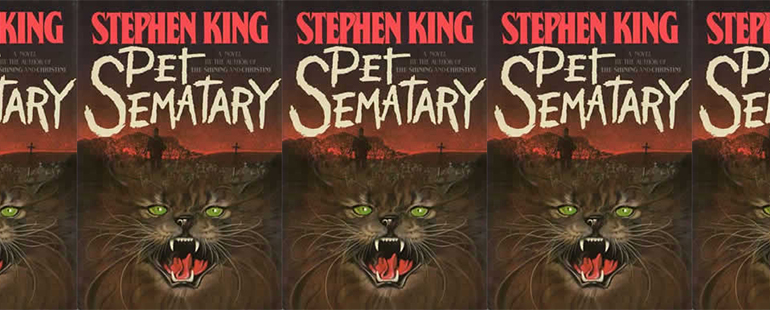Death as the Villain in Pet Sematary

Last month, in preparation for a long flight, I decided to give myself a little treat and downloaded the audio version of Stephen King’s Pet Sematary (1983), as read by Michael C. Hall. Over the past couple of decades, King (whose own writing was recently featured in Ploughshares) has come to signify for me a delicious kind of pleasure. I read one of his books whenever I want something engrossing and indulgent that nevertheless still feels masterful. But for years I’d been hesitant about Pet Sematary. I hadn’t read it or watched the movies, but I knew enough about it to give me pause. I mean, seriously? An evil kitty? Can’t we do a little better than that?
I absolutely love the King classics, but I find some of his villains are more compelling than others. Though I enjoy the twisted fantasies his mind conjures, I find it much easier to get behind Misery (1987), which deals with a crazed fan, than Cujo (1981), in which the villain is a rabid dog. Regardless of which he chooses, King’s sources of fright are imbued with an otherworldly charge of evil, which can be a double-edged sword—both highlighting and distracting from the sufficiently terrifying realities of this world. Though I admire the way King always uses the monsters in his writing as symbols of deeper fears and traumas, filling them with subtext, what I knew about Pet Sematary made it seem just a little too hokey. It didn’t seem to be able to stand up to some of his more complex ideas as a writer able to write books about the helplessness of childhood, the devastation of substance use disorder, or the terror of the U.S. government while using the guises of a murderous clown, a haunted hotel, or a town full of vampires to evoke scares. A scary cat forged in a Native American burial ground sounded a little like something out of Scooby-Doo.
Of course, none of this stopped me from devouring the book over two weeks of indulgent pleasure, nervous chills, and eerie nightmares. The plot is simple and known to many by this point, years after publication and the release of two famous film adaptations: Louis Creed and his family move to rural Maine, to a house that borders a lethal road on a property that includes a child-made graveyard for beloved pets. Beyond the graveyard, a path leads to an ancient, enchanted Native American burial ground, where, people have discovered, buried bodies come back to life, though are always a little different than they were pre-death. Those who bury their pets in the burial ground typically put them down again after their reanimation: when they returned they were changed—cold-tongued and oily-skinned, decidedly creepy, and, on rare occasion, even aggressive. Only one person has ever buried a human being in the area, and that turned out to be a grave mistake. Though Louis Creed knows this, when his young son is killed by a truck on the road outside his front yard, he can’t stop himself from giving it another go.
As I read, I realized that this book had something much deeper to offer than its premise: the zombie-like resurrected are frightening, the violent deaths and rebirths are startling, and the spirits that dwell at the burial ground are haunting. But beneath all that, at its core, the book is about something much simpler than waking nightmares, reanimated children, or the mythological Wendigo. Pet Sematary is about a much more fundamental and universal experience—grief and the fear of death.
In the novel, we witness kindergartener Ellie Creed coming to terms with the concept of death as she fears for the safety of her cat, Church, and attends the funeral of her elderly neighbor, Norma Crandall. Readers can intuit that from this year onward, Ellie’s life, like all of ours, will be touched from time to time by the ache of death and parting, and continuously haunted by the knowledge, the presence, and the promise of it. Death, or as Louis Creed comes to think of it, “Oz, the Gweat and Tewwible,” lurks at every corner, though we do our best to ignore it. Whether we are like Louis—a physician comfortable enough with the concept of demise—or his wife, Rachel—whose sister’s traumatic childhood death has left her incapable of even acknowledging the possibility—we know that loving anyone or anything means accepting their transient presence in our lives. And when death hits close to home, or even just threatens to, we will willingly let go of our equanimity (and sometimes our sanity) and fall into an abyss of magical thinking. This is the terror at the heart of Pet Sematary: watching Louis Creed falling into that abyss in an attempt to bring back his toddler, and knowing that none of us would be strong enough to keep our footing, were we in his place.
“The soil of a man’s heart is stonier,” Jud Crandall, Louis’s neighbor, says early on in the book. “A man grows what he can, and he tends it. ’Cause what you buy is what you own.” In loving others, in marrying and procreating, we give ourselves over to the possibility—or, some might say, the imperative—of loss and heartache. But what would you do if you could reverse this terrible pain? We are responsible for those that we bind our lives to, no matter who—or what—they turn into. When we have children or adopt pets, we commit to them, regardless of the cost. Pet Sematary takes this idea further by examining our responsibility to those we choose to bring back from death, deciding that their continuing presence in our lives trumps whatever unspeakable changes might have occurred in them. Whether they come back cold to the touch, or malicious, or blood-thirsty, it is up to us to care for them or put them down.
Madness is often defined as doing the same thing over and over again while expecting different results, and that is certainly what happens to Louis Creed. He has already made the fateful mistake of burying his two-year-old son, Gage, in the Native American burial ground—only to have him come back a murderous ghoul—and made the difficult decision to afterward put him down, but by the end of the book, he can’t help but bury his wife (who was murdered by Gage) there too. One might read this as Louis practicing the same responsibility Jud referred to—his lifelong commitment to his wife and son extended beyond the grave. But that theory doesn’t quite accommodate the fact that while he is busy burying and reburying them, his daughter is slowly losing her sanity to recurring nightmares at her grandparents’ house, desperate for a loving parent’s presence. Another interpretation could be that, as a man of medicine, Louis cannot resist the temptation to play God. But I think that in crafting Louis’ frustrating decisions, King is also pointing to a much simpler fact: grief is the greatest compulsion of all. It makes us stupid with obsession and greedy with magical thinking, and we will do anything we can think of to make it stop. When King describes death as the force that pulls people toward the burial ground, that urges them to bring others there even when they know they oughtn’t, that prevents Rachel from getting back to Maine in time to stop Louis from exhuming and reburying their son, what he is really saying is that the notion of death is a constant terror in our lives and that our desire to escape it, avoid it, and suppress it is an undertone that steers us toward emotional, irrational, and sometimes fatal choices.
No less frightening than the certainty of death is the way in which we are eager to ignore it, to the point of inflicting pain on our loved ones, taking them for granted, lying and terrorizing and cheating them, and allowing our ugly, selfish urges to run rampant, only so we can ignore the fact that the people we care about are only here temporarily—until it is too late. These are some of the atrocities revealed and demonstrated by the dying and the living dead in Pet Sematary, and it is why what got to me most of all wasn’t the resurrected with their violent urges, superhuman strength, or clairvoyant knowledge. I don’t need King to demonstrate what humans don’t understand about death and its irreversibility. In fact, I hardly need the dead at all. Zelda, Rachel’s sister, dying in bed of spinal meningitis and turning hateful and malicious from pain and suffering is terrifying enough without all-knowing, supernatural zombies mirroring and exaggerating her natural, human evil. The poster of Oz the Gweat and Tewwible on her wall is a harsh enough reminder of how death haunts and compels us, precisely because we don’t understand it at all.
This piece was originally published on July 26, 2021.



